2020 was … well, you know how 2020 was. But 2020 was also a year with thirty-three new episodes of Star Trek, the most new Trek to debut over the course of a single year since Star Trek: Voyager went off the air – ending the 90s “golden age” of multiple Trek series running concurrently – two decades ago. It could easily be argued that 2020 was the beginning of a new golden age for Star Trek, a year in which there were more weeks with a new episode of Trek than there were weeks without one. While I, personally, haven’t loved every choice Trek’s creative teams have made this year, I do love the potential of having so many creative teams working on so many distinct visions for a fictional universe that means a lot to me. And in a year largely characterized by worries which we, as individuals alone, could do very little about, even just being constructively critical of so much new Star Trek has felt refreshing (even if I haven’t quite been in the headspace lately to write out as much of that criticism as I’d hoped).
And so, with 2020 now behind us (for better and for worse), I thought I’d do something I’ve never had the chance to do with Trek vs. Trek before: a review of my 20 favorite new Star Trek episodes, out of the 33 that debuted in 2020. I’ll keep my thoughts relatively brief on most of these episodes, and I thought I’d list my choices in the order they first aired, rather than ranking them. *Spoiler warning: I’ll be mentioning some crucial plot points from season 1 of Star Trek: Picard, season 1 of Star Trek: Lower Decks, and season 3 of Star Trek: Discovery (and the end of its 2nd season, as well). This list goes month by month, and series by series (Short Treks, then Picard, then Lower Decks, then Discovery), so keep that in mind if there’s a series you’re still catching up on.
JANUARY
“Children of Mars” (Star Trek: Short Treks, season 2, episode 6)

Written by Kirsten Beyer, Alex Kurtzman, and Jenny Lumet; directed by Mark Pellington.
Yes, it’s fair to ask if this is more a music video, and/or an ad for Star Trek: Picard, than an episode of Star Trek unto itself. But looking way, way back, now, to January of 2020, “Children of Mars” feels like a surprisingly appropriate way to have started that year. Its basic premise – “innocent bystanders, initially caught up in their own lives, watch helplessly as world events change those lives forever” – hits harder now (for, um, a few reasons) than it did in January 2020, when the event it seemed to be referencing most closely was the 9/11 attacks, almost 20 years earlier. But it also set the tone for the Star Trek we’d get in 2020 by exploring a side of the Trek universe which hadn’t been the main focus of any of its previous series: the lives of pre-teen girls, not going to Starfleet Academy in preparation for becoming the protagonists of their own show, but simply living their emotionally turbulent pre-teen lives, as played out in the impressively intense performances of young guest actors Ilamaria Ebrahim and Sadie Munroe.
(You can read my piece comparing “Children of Mars” to the 2019 Short Trek “Ephraim and Dot” here.)
“Remembrance” (Star Trek: Picard, season 1, episode 1)

Teleplay by Akiva Goldsman & James Duff; story by Akiva Goldsman & Michael Chabon & Kirsten Beyer & Alex Kurtzman & James Duff; directed by Hanelle M. Culpepper.
The first episode of Picard was an hour of television with a near-impossible job to accomplish, navigating fans’ attachment to, and expectations for, its title character, while also staying true to the writers’ (and of course, Sir Patrick Stewart’s) sense of who that character would be 25 years after the end of The Next Generation, and adding something new to Star Trek, to boot. And while I had my reservations about the path of “mystery box” storytelling that this first episode was so clearly setting the series on (reservations which were only reinforced as the season went on), “Remembrance” won me over anyway with its genuinely touching handling of Picard’s feelings for his old friend Data; the way he speaks to Dahj about her “father” is such a perfect tribute to that beloved character that it genuinely chokes me up, every time. It also doesn’t hurt that Stewart’s performance here is everything we’d expect it to be, or that Orla Brady and Jamie McShane are instantly endearing as the newly-introduced Romulan spies-turned-groundskeepers, Laris and Zhaban.
FEBRUARY
“The End is the Beginning” (Star Trek: Picard, season 1, episode 3)

Written by Michael Chabon & James Duff; directed by Hanelle M. Culpepper.
Wrapping up the 3-episode opening arc of Picard’s first season, this episode effectively rounds out our understanding of the 25th-century Trek universe, flashing back to Picard and Raffi running up against the unwillingness of some Federation worlds to devote resources to helping the Romulans in the aftermath of the attack we witnessed in “Children of Mars” (a darker take on the Federation than some Trek fans prefer, I know, but one which felt very real to me on my first viewing, and which only feels more real at the end of 2020 and the beginning of 2021). This episode also: features the delightful Jonathan Del Arco reprising his role as Hugh; marks a return to the always-intriguing concept of Emergency Holograms, when we’re introduced to Captain Rios and his crew, all well played by Santiago Cabrera; and is, sadly, our last chance (so far) to spend time with Laris and Zhaban, whom I would gladly watch more of.
(You can read my piece on Hugh’s first appearance, in The Next Generation, here.)
“Absolute Candor” (Star Trek: Picard, season 1, episode 4)
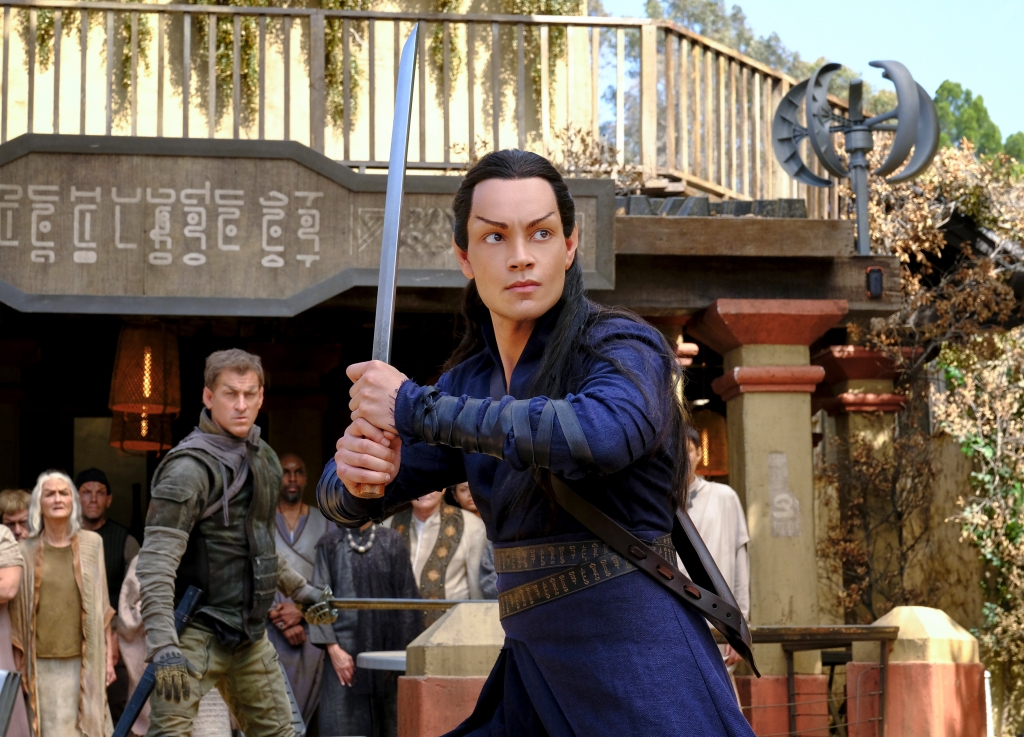
Written by Michael Chabon; directed by Jonathan Frakes.
More rounding out of the Trek universe here, as our understanding of Romulan society – an element of Star Trek lore I’ve always found to be a bit lacking – is deepened with the intriguing concept of a sect who counter that notorious Romulan secrecy and paranoia with their adherence to “absolute candor.” We’re introduced to the innocent-but-deadly space-Legolas, Elnor, another character I think could carry many more stories than we’ve gotten so far … and, oh yeah, the dramatic return of another of Star Trek’s most iconic and beloved characters, when Jeri Ryan finally appears as a clearly changed Seven of Nine.
“The Impossible Box” (Star Trek: Picard, season 1, episode 6)
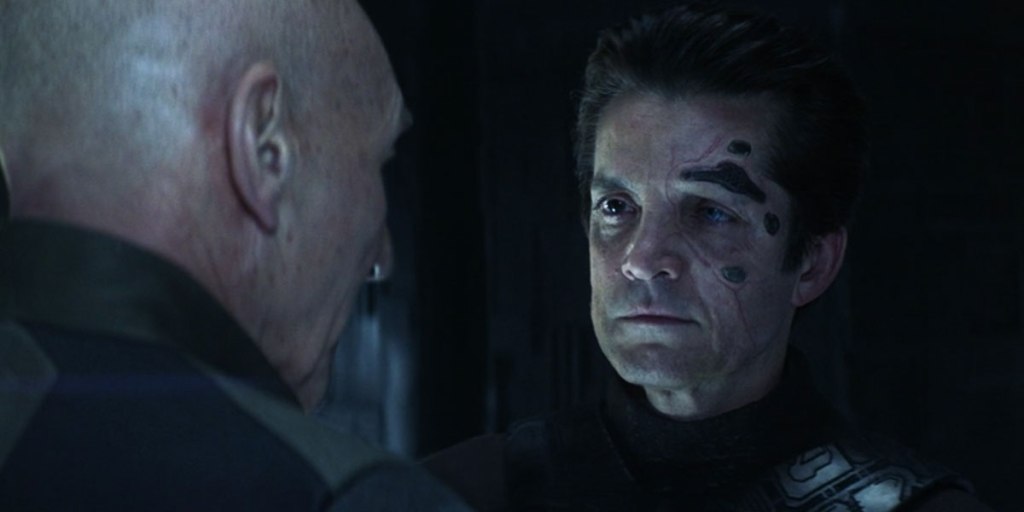
Written by Nick Zayas; directed by Maja Vrvilo.
Former Borg drone Hugh is reunited with former Borg drone Picard, and it’s exactly as satisfying a moment as it should be. Other stuff happens, too, including some stuff involving Narek and Narissa, two of the least interesting recurring characters in all of Star Trek, whom I could not care less about if I tried. Mainly, Hugh hugs Picard, and it’s delightful.
MARCH
“Nepenthe” (Star Trek: Picard, season 1, episode 7)
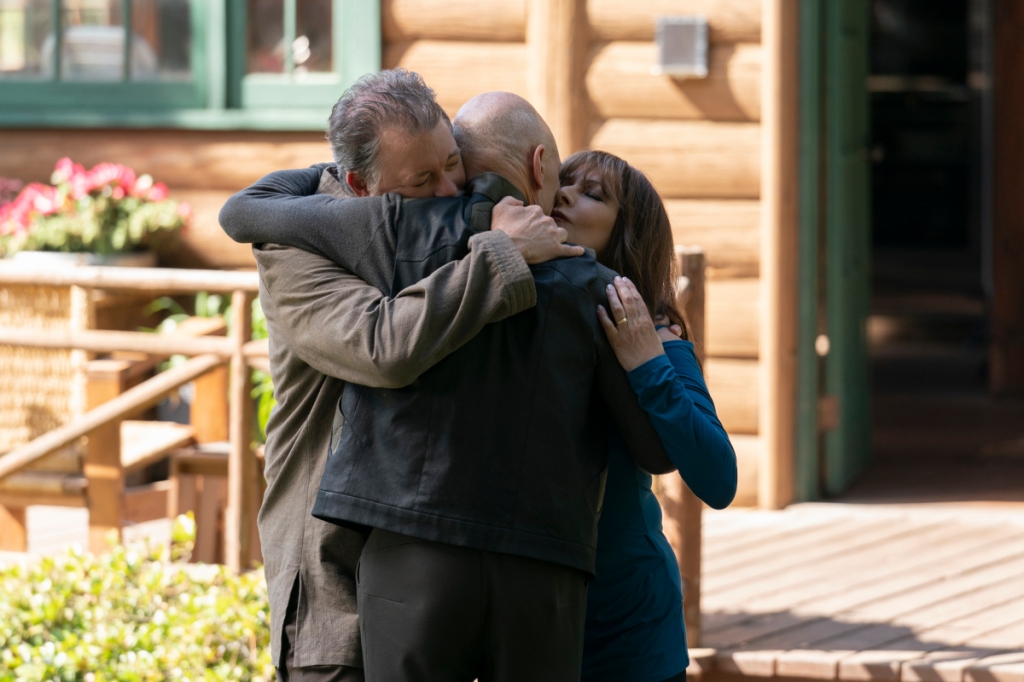
Written by Samantha Humphrey and Michael Chabon; directed by Douglas Aarniokoski.
Again, beloved Star Trek characters return after decades; again, they hug Picard; and again, it’s delightful. “Nepenthe” is my second-favorite new Star Trek episode of 2020, and would probably be my favorite, period, if it didn’t include Trek’s biggest and most frustrating misstep of 2020, when Hugh, so recently returned, is off-handedly killed by utterly forgettable stock villain Narissa. She and Narek consistently feel like walking examples of the wrong lessons Hollywood has learned from the success of “prestige television” like Game of Thrones, and the manner of Hugh’s death strikes me as the apotheosis of those misunderstandings as reflected in Discovery-era Star Trek – the death of a rich, beloved character reduced to a minor motivating event in someone else’s story, rather than the rightful end of his own. This glaring problem with “Nepenthe” is all the more striking, all the more difficult to ignore, for how fundamentally differently it’s handled than this episode’s A-story. From the moment they’re first re-introduced, Troi and Riker never feel like mere stepping stones to the next big plot point in someone else’s season-long story arc. It’s made clear almost immediately that they have very much lived lives of their own since The Next Generation ended, and their reunion with Picard really feels like the reunion of very close friends who haven’t seen each other in a very long time, not just characters who must come together purely for plot reasons. I’ve heard complaints that the sad backstory of the Troi-Rikers’ late son needlessly adds more darkness to an already dark series, but I strongly disagree, precisely because that is exactly what it’s like to have someone come back into your life after years and years – to learn that big, profound, sometimes tragic things have happened in their lives that had nothing to do with you … and that you can still be a part of their lives, regardless. This reunion was always going to be effective fan service, simply because of who these characters are, and what they mean to so many fans of TNG. But it ended up being so much more than that, so much truer to these characters and to the realities of human relationships than it could have gotten away with being. Whatever else it’s about, Star Trek has always been about humanity first and foremost, and it’s hard to think of many episodes in all of Trek that have managed to capture what it feels like to be human, and to care about other humans, quite the way that “Nepenthe” does.
“Broken Pieces” (Star Trek: Picard, season 1, episode 8)

Written by Michael Chabon; directed by Maja Vrvilo.
“Nepenthe” is a tough act to follow, and “Broken Pieces” marks Picard’s return to its mad rush to resolve plot points, introduce more plot points, then maybe resolve those, too – a process I find much, much less compelling to watch than the sort of subtle, gradual character work which “Nepenthe” let take center stage. But “Broken Pieces” made my list for its fun and intriguing use of La Sirena’s holographic crew, as Santiago Cabrera gets to show off his own acting chops by doing plenty of character work on Rios, not just as Rios, but as all the holograms based on him, whose understanding of things Raffi must use to piece together a greater understanding of Rios himself (and the idea that the holograms’ accents are a bit, um, over the top because they’re based on how Rios would imitate those accents is one of the most charming fan theories I’ve come across in some time).
“Et in Arcadia Ego, Part 2” (Star Trek: Picard, season 1, episode 10)
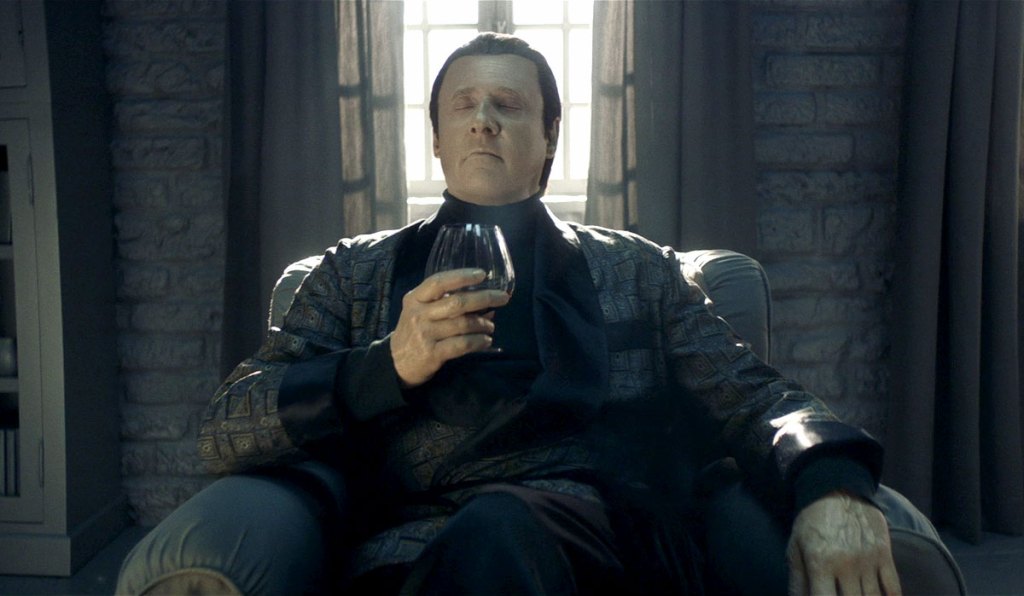
Teleplay by Michael Chabon; story by Michael Chabon & Akiva Goldsman; directed by Akiva Goldsman.
Honestly, I’m torn on the end of Picard’s first season. As I’ve alluded to above, I found the season’s overarching “mystery box” plotline to be, at best, far less interesting than the character work being done around it. And in my opinion, that plotline truly falls apart in the 2-part season finale, its antagonists feeling generic and 2-dimensional, and its resolution feeling rushed almost to the point of incomprehensibility. (I’ve become increasingly convinced that this season of Picard fell victim to the same infamous pitfall as Game of Thrones, with its creative team so focused on using the show as a vehicle to get to a particular story point – in this case, the touching reunion in “Nepenthe” – that once that point had been reached, the show went into autopilot and veered fully into much more formulaic, much less meaningful territory.) But once most of that 2-part finale has been sacrificed to the plot gods, what remains is, again, exactly the kind of character moments that highlight the true strengths of this series, with more great work from Santiago Cabrera and Jeri Ryan in particular … and, of course, from Brent Spiner. Throughout the season, Picard has excelled at showing us how deeply Data touched the lives of his Enterprise crewmates, and the handling of his final scenes, here, is night and day from the way Hugh’s death was presented to us. The idea that Data would see death as a crucial, meaningful part of his exploration of humanity tracks perfectly as the end of an arc he began in The Next Generation, and his final conversations with his old captain feel not just like a plot point for Picard’s benefit, but a fitting, touching, and again, meaningful conclusion to Data’s own story.
AUGUST
“Second Contact” (Star Trek: Lower Decks, season 1, episode 1)

Written by Mike McMahon; directed by Barry J. Kelly.
After Picard attempted – successfully in some ways, unsuccessfully in others – to take us beyond the Trek universe as we knew it in the TNG era, Lower Decks comes along and does, in some ways, the exact opposite, returning to a more familiar setting for Star Trek, but turning our view of that setting by 90 degrees, and letting us see another side of it. With its title alone, “Second Contact” signals that Lower Decks both will and won’t be a return to Trek’s “good old days,” and starting right from the apparent captain’s log that opens the episode – an old narrative device which has largely been left behind by Discovery-era Star Trek – we can tell that its tone will be both reverent and irreverent to the Trek that came before it. This first episode is a fun, effective introduction to Trek’s first animated series since, well, The Animated Series, and to its first dedicated comedy series ever, and it nicely hangs a lantern on the series title’s homage to the classic TNG episode “Lower Decks” by having its junior crew cast members both live their normal lives and save the day while the upper-decks crew are busy seeing themselves as the heroes.
(You can read my piece comparing “Second Contact” with the TNG episode “Lower Decks” here.)
“Temporal Edict” (Star Trek: Lower Decks, season 1, episode 3)

Written by Dave Ihlenfeld & David Wright; directed by Bob Suarez.
I’ll be honest: the animation on Tendi’s expression and body language while intensely rocking out on the drums is probably enough, in itself, to put this episode on my list. But beyond that, Captain’s Freeman’s elimination of “buffer time” from the crew’s schedule, and the chaos that ensues, is both a fun call-back to elements of older Trek like Scotty’s inflated repair times or Captain Jelicho’s revamping of the Enterprise’s shift schedule, and a clever way of tapping into why those elements worked in the first place: the sense that a starship, gliding through the cold, empty vacuum of space, could actually be a living community, a home where people live and work and coexist. Oh, and Commander Ransom does some good-old-fashioned shirtless fighting, Kirk-style.
“Moist Vessel” (Star Trek: Lower Decks, season 1, episode 4)

Written by Ann Kim; directed by Barry J. Kelly.
Again, Tendi kind of steals the show here, with her storyline’s sendup of the very Trek-ish trope of ascending to a higher plane of consciousness. But we also get an important moment of understanding between mother and daughter Freeman and Mariner, which cements their gradually developing understanding of each other’s methods and motivations as the central arc of this first season of Lower Decks.
SEPTEMBER
“Terminal Provocations” (Star Trek: Lower Decks, season 1, episode 6)

Written by John Cochran; directed by Bob Suarez.
I mean, you knew the Badgey episode was going to be on this list, right? The holodeck is a concept perfectly suited to animation, and while the Badgey plot in this episode is a boilerplate “the holodeck is malfunctioning and trying to kill us” story in the tradition of TNG’s “A Fistful of Datas” or DS9’s“Our Man Bashir,” the visual design on Badgey is perfectly cartoony in a way that could probably never work outside of an animated series, but feels very true to how the technology might actually be used, and the voice acting of guest star Jack McBrayer perfectly walks the line between cutesy and creepy.
(You can read my piece comparing classic holodeck episodes “A Fistful of Datas” and “Our Man Bashir” here.)
OCTOBER
“Crisis Point” (Star Trek: Lower Decks, season 1, episode 9)
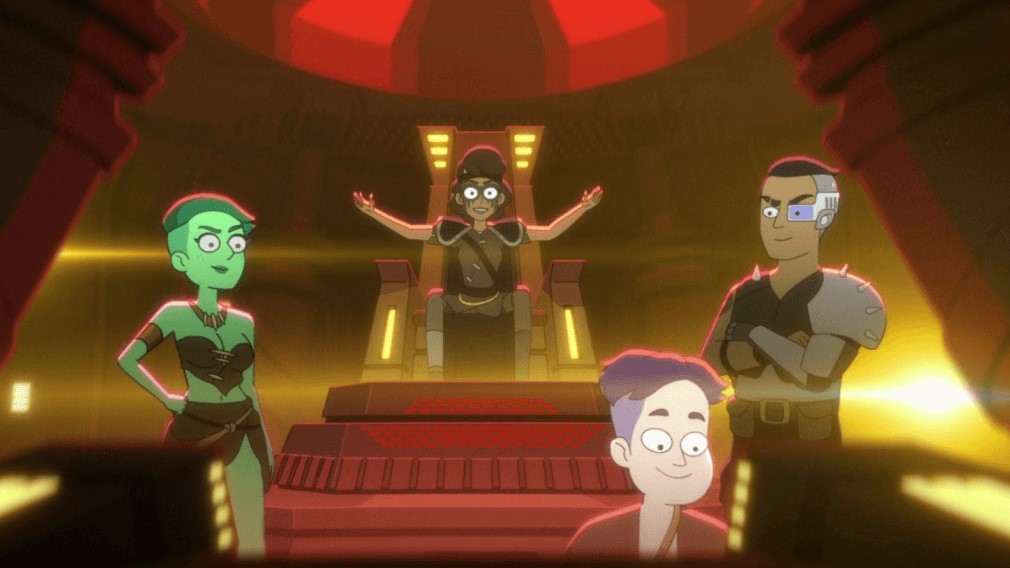
Written by Ben Rodgers; directed by Bob Suarez.
Another clever use of the holodeck, in a medium which can make the most of it. But where “Terminal Provocations” pays homage to the Trek trope of holodeck malfunctions, “Crisis Point” follows more closely in the footsteps of episodes like TNG’s “Hollow Pursuits” and DS9’s “It’s Only a Paper Moon,” exploring the ways people might actually use the holodeck when it isn’t malfunctioning and what that might say about them, and about the way we use our own outlets of expression in the present. We see Mariner and Boimler, here, each using the holo-program exactly how they would use it, and in a couple of ways such technology would inevitably be used in real life – Mariner vents her frustrations through elaborate fantasies of power and revenge, while Boimler plays out simulations of how to suck up to his boss. Yes, this episode crams in maybe more fan-service Trek references than any episode of Lower Decks so far, but it does so without diluting its interesting, literalized exploration of Mariner as her own worst enemy, an important moment in both her own character arc and in the season’s ongoing questioning of how, and if, and why the utopian Federation actually works.
“No Small Parts” (Star Trek: Lower Decks, season 1, episode 10)

Written by Mike McMahon; directed by Barry J. Kelly.
My favorite new episode of Star Trek in 2020. Where “Nepenthe” contained my favorite Trek moments of the year alongside a serious and frustrating misstep that I simply can’t overlook, “No Small Parts” is the kind of tight, complete, deliberate package of an episode that both the first season of Picard and previous seasons of Discovery, as much as I generally enjoy them, often struggle to deliver, thanks in part to their all-consuming focus on plot-heavy, mystery-driven, season-long arcs. Ironically, then, “No Small Parts” lands Lower Decks’ first-season arc much more gracefully and satisfyingly than Picard does. As I wrote previously about this episode:
“It successfully pays off the thematic promises made at the beginning of the season by “Second Contact,” proving that Lower Decks can be – that it is – more than a collection of in-jokes for Trek fans, but a series with something serious to say about Star Trek, from a distinct and thoughtful perspective within that franchise. “No Small Parts” demonstrates this not just by turning the Pakleds into a credible threat, though that in itself is impressive; while Lower Decks is undeniably a comedy, “No Small Parts” succeeds in using the powered-up Pakleds to set a dramatic tone, and establish stakes that feel serious and real, in a way that rivals almost anything we’ve seen from Discovery or Picard. But this episode also brings Ensign Mariner’s first-season arc full circle when her mother, Captain Freeman, finally says out loud what the series had been implying since its first episode: while Freeman believes in the ideals of the Federation, she can clearly see its limitations – in-universe limitations which mirror the real-world limitations of Star Trek’s creative teams – and acknowledges the value of someone like Mariner, who is less bound by the letter of the law than by its spirit.”
(You can read the rest of my piece comparing “No Small Parts” to the Pakleds’ first appearance in “Samaritan Snare” here.)
“Far From Home” (Star Trek: Discovery, season 3, episode 2)
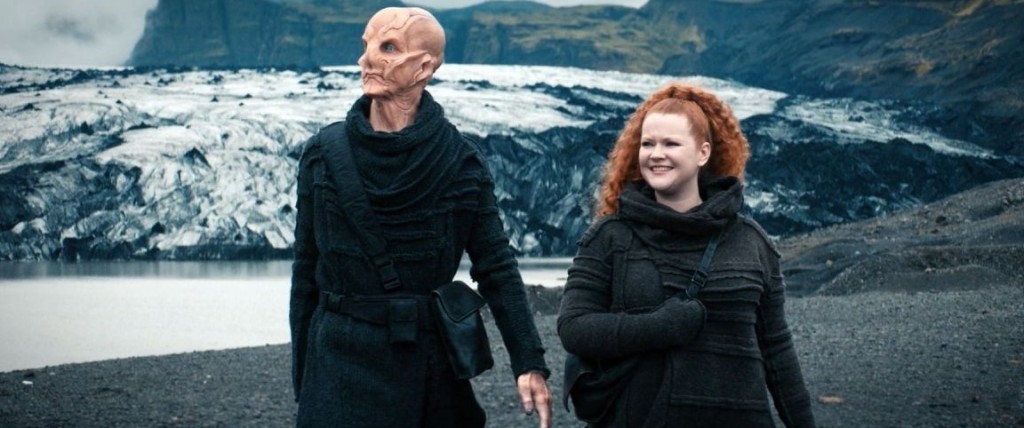
Written by Michelle Paradise & Jenny Lumet & Alex Kurtzman; directed by Olatunde Osunsanmi.
While I’ve had my criticisms of Discovery through its first and second seasons, this is a series that I very much want to love, and I was excited for something of a new start this season, with its new setting in Star Trek’s far, far future. “Far From Home” makes the interesting choice to use that unique setting to tell a story which is, in many ways, boilerplate Trek, as the crew brings the hope of an enlightened Federation to a troubled, oppressed world … with the twist, of course, being that it appears to have largely been the future decline of the Federation that left the inhabitants of “The Colony” in such dire straits in the first place. This episode neatly sets up the season’s exploration of how the Federation’s ideals might be preserved in a future without the plentiful resources which originally made those ideals sustainable, and it does so while making time for some great character moments from the interesting pairings of Tilly and Saru, Nhan and Georgiou, and Stamets and Reno.
NOVEMBER
“Forget Me Not” (Star Trek: Discovery, season 3, episode 4)

Written by Alan McElroy & Chris Silvestri & Anthony Maranville; directed by Hanelle M. Culpepper.
The potential of Discovery’s third-season far-future setting continues to play out here, with the return of a Star Trek species associated with the post-Original Series era of TNG and DS9, one full of fascinating potential: the Trill, and the symbionts with whom they share a lifetime-bridging bond. We also learn more about Adira, Star Trek’s first canonically non-binary human character (though this isn’t made explicit about them, in-universe, until a later episode), and their boyfriend Gray, Star Trek’s first canonically trans recurring character, through a series of symbiont-induced visions. These scenes are beautifully shot, with consistently compelling performances by Blu del Barrio as Adira and Ian Alexander as Gray. I do have some reservations about the tragic nature of their relationship as it’s portrayed here, given the persistent, troubling trope of the “doomed” queer relationship in popular fiction, and Discovery’s own prior, controversial embrace of that trope. But the story of Adira joining with the Tal symbiont, and their subsequent reunion with Gray and discovery of a new “found family” in Tal’s previous Trill hosts, is a clever and genuinely touching use of a sci-fi premise I’ve long hoped Star Trek would return to, and the ship’s computer using that old Enterprise tradition of “movie night” to help smooth over the crew’s frayed nerves is a welcome hint at this season’s further development of the “sphere data” into Zora, an intriguing character from the standout Short Trek,and one of my overall favorite episodes from the Discovery era of Star Trek, “Calypso.”
(You can read my piece comparing “Calypso” with the TNG episode “Data’s Day” here.)
“Unification III” (Star Trek: Discovery, season 3, episode 7)

Written by Kirsten Beyer; directed by Jon Dudkowski.
Again, Discovery makes clever use of its farther-future setting, this time by letting previously-introduced elements of Star Trek lore play out to a logical but “fascinating” conclusion. We learn that following the destruction of the Romulan homeworld (as seen in the 2009 Star Trek film and further explored throughout Picard’s first season), Spock’s attempts at reunification of the Romulan and Vulcan peoples (as seen in The Next Generation episodes “Unification I” and “Unification II”) were eventually, ultimately successful. And what’s more, Michael Burnham not only learns of all that her brother accomplished after she left him in the past, but gets to see firsthand the long-term legacy of those accomplishments on the renamed Vulcan/Romulan homeworld, Ni’Var (where she’s also reunited with her time-displaced mother, as played by the always-welcome Sonja Sohn). “Unification III” continues the Discovery tradition of episodes like the first season’s “Lethe” and the second season’s “If Memory Serves,” taking full advantage of Star Trek’s decades-long, generation-spanning continuity of overlapping stories to create the kind of character moments that might only be possible in such a long-running and multifaceted fictional universe; not unlike “Nepenthe,” it takes what could have been cheap fan service and uses it as a surprisingly sturdy foundation for genuinely touching character moments and genuinely satisfying payoffs to previous world-building.
DECEMBER
“Terra Firma, Part 1” and “Terra Firma, Part 2” (Star Trek: Discovery, season 3, episodes 9 and 10)

Teleplay by Alan McElroy; Story by Bo Yeon Kim & Erika Lippoldt & Alan McElroy; directed by Omar Madha.
I’m going to cheat a bit, here, and write about both parts of “Terra Firma” together, since it really just doesn’t make much sense to treat them as anything other than a single story. Again, we have fan service handled with an impressively soft touch in the return of one of Star Trek’s most iconic images and concepts, the Guardian of Forever (even if I was convinced, throughout most of my unspoiled first viewing, that the impish Carl, well played by Paul Guilfoyle, was actually a member of the Q Continuum). As a farewell to Mirror Georgiou (at least before she reappears in another series), “Terra Firma” does the important work of re-contextualizing her in a way that is, to my mind, very necessary if she is to continue as a Star Trek protagonist (and which, honestly, would have made me more comfortable with her inclusion throughout seasons 2 and 3 of Discovery if it had been done sooner). While Michelle Yeoh is always welcome as a joy to watch on screen, it’s been hard, at times, not to feel like the show’s tendency to frame her character as a “yas queen” badass depended on our forgetting that she led a fascist, genocidal empire that committed countless atrocities in her name (and in fact, giving the order to commit one of those atrocities, a mass murder of alien rebels, was literally the first thing we ever saw the character do when she was first introduced in the first-season episode “The Wolf Inside”). Here, though, we learn that, as brutal as she can be by Federation standards, Georgiou had become remorseful of the Terran Empire’s brutal ways, and had been working quietly towards making it less genocide-y – while keeping up murderous appearances, in order to avoid getting murdered herself – at the point where we first met her (even if that does, perhaps, require a bit of mental ret-conning of her willingness to blow up the Klingon homeworld and everyone on it at the end of season 1). The crew’s “memorial” for her, at the end of “Part 2,” does unfortunately muddy the overall message a bit, in a way I find frustrating; yes, we have seen by that point that she isn’t exactly the genocidal warlord she appears to be, but the crew of the Discovery haven’t seen that, and their heartfelt words about her feel like they only really make sense as a fan-service-y farewell to the actor, not as something they should actually be saying about the character. Setting those last moments aside, though, her story is well-handled here, Yeoh is as charismatic and compelling as ever, and the visual design of the Terran Empire – the costuming, in particular – is every bit as truly impressive as it was in Discovery’s first season.
“Su’Kal” (Star Trek: Discovery, season 3, episode 11)

Written by Anne Cofell Saunders; directed by Norma Bailey.
Again, we get a surprisingly traditional Star Trek story embedded in this season’s “race to the mystery box.” The idea of a child left without family on a starship, and raised to adulthood by holograms, is simultaneously boilerplate sci-fi and a fresh, emotionally impactful idea that cuts to the heart of something Star Trek has always been about: growth through connection with others. Still, as compelling and well-told as I find Su’Kal’s story to be – and as good as it is to once again see the holodeck, as a concept, being used in inventive, thought-provoking ways – I can’t help but fixate on this episode’s continuation of a long Trek tradition, as it changes up its characters’ alien makeup and prosthetics, giving us Trill Burnham, Bajoran Culber, and human Saru! As incredible a job as he always does emoting through all those Kelpien prosthetics, it’s a lot of fun to see the perennially-monstered-up Doug Jones walking around on screen as a regular old human being; and as a huge fan of Deep Space Nine, I found it weirdly satisfying to see Wilson Cruz wearing that Bajoran earring and those nose-ridges. (And another tried-and-true Trek tradition would be upheld in the next episode, “There is a Tide,” when Kenneth Mitchell, who previously appeared on Discovery as Klingons Kol, Kol-Sha, and Tenavik, returns as the mild-mannered, hoverchair-using human scientist, Aurellio.) More seriously, though, much of what would follow “Su’Kal” to wrap up Discovery’s third season would be focused on the sort of heroic action-adventure which, while very well done on a technical level, is not really what I’m looking for, personally, from Star Trek; the Emerald Chain, while certainly much less flat and generic than the antagonists from Picard, is never quite given enough depth to rise above being just “the bad guys” and present any sort of real philosophical challenge to the Federation. But by far the most interesting parts of the season finale, “That Hope is You, Part 2” (which technically isn’t on this list, since it technically didn’t debut in 2020), are set up by “Su’Kal”; as someone who has been consistently (and maybe annoyingly) critical of contemporary Star Trek’s overreliance on “mystery box” storytelling, there’s something I find very satisfying about having the “mystery box” turn out to be poor old Su’Kal himself, who must connect with another lonely Kelpien, Saru, in order to overcome his fears and discover what lies “outside” the only world he knows. In other words, the “mystery” was pretty much just something Star Trek has been telling us all along … but something we can always stand to hear again.
I’ll be honest, I appreciate that your post is about ‘new’ Trek so picking your best out of 2020’s output is beyond thankless. I hated Star Trek: Discovery and was numbed by Star Trek: Picard. I don’t really consider either of them ‘Trek’ and they both sent me scurrying back to my TOS Blu-rays. The fact that a 1960s show that was so limited by budget and technology could still be more exciting, challenging and progressive compared to the new incarnations never ceases to amaze me. Nothing ever thrilled like Doomsday Machine, or fascinated like City on the Edge of Forever or disturbed like The Menagerie (which creeped me out as a kid and still does to this day).
LikeLike